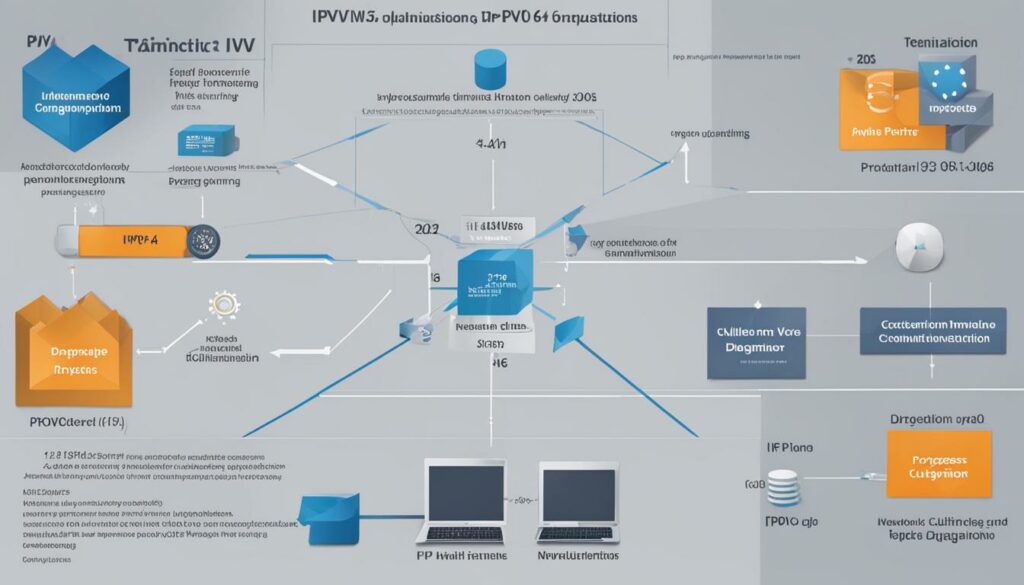Welcome to Section 1 of our article on IPv6. In this section, we’ll provide an overview of IPv6, covering its basics and the importance of understanding this new internet protocol.
IPv6, also known as Internet Protocol version 6, is the next generation of the internet protocol. It has been developed to address the limitations of the current version, IPv4, and to ensure the continued growth of the internet.
Understanding IPv6 is essential in today’s digital landscape, as it provides a much larger address space compared to IPv4. With the increasing number of devices connected to the internet, IPv6’s 128-bit addresses allow for approximately 3.4×10^38 unique IP addresses, ensuring we won’t run out anytime soon.
To get the most out of IPv6, it’s crucial to grasp its basics, including how it works, its features, and the challenges it presents. By familiarizing yourself with the IPv6 protocol, you’ll be well-equipped to navigate the transition from IPv4 and take advantage of its numerous benefits.
To ensure optimal performance when working with IPv6, we recommend WordPress Hosting from BoostedHost. Sign up now through this link to experience seamless and efficient WordPress hosting.
Key Takeaways:
- IPv6 is the next generation internet protocol designed to replace IPv4.
- IPv6 provides a significantly larger address space compared to IPv4, essential for the growth of the internet and increasing number of connected devices.
- Understanding the basics of IPv6, including how it works and its features, is crucial in today’s digital landscape.
- Transitioning from IPv4 to IPv6 poses challenges but offers numerous benefits, such as improved network performance and enhanced security.
- Consider BoostedHost’s WordPress Hosting for optimal performance and seamless management of your IPv6-powered website.
What is IPv6?
IPv6 is the latest version of the Internet Protocol, designed to replace its predecessor, IPv4. It introduces several key features and enhancements, revolutionizing the way devices connect and communicate on the internet.
One of the most significant changes in IPv6 is its addressing scheme. Unlike IPv4, which uses 32-bit addresses, IPv6 utilizes 128-bit addresses. This expansion in address space allows for a much larger pool of unique IP addresses, ensuring the continued growth of the internet.
The structure of IPv6 addresses is defined by the RFC 4291 standard. Each IPv6 address is divided into two main parts: the network component and the node component. The network component is responsible for routing, determining how packets are transmitted across networks. The node component, on the other hand, identifies a specific interface or node within the network.
IPv6 also introduces new features and communication types. One of these features is jumbograms, which enable the handling of larger packets, improving efficiency and performance. Additionally, IPv6 supports various communication types, including unicast (one-to-one communication), anycast (one-to-nearest communication), and multicast (one-to-many communication).
IPv6 Addressing Structure:
| Component | Description |
|---|---|
| Network Component | The network portion of the address used for routing. |
| Node Component | The interface or node portion of the address. |
With the increased address space and advanced features, IPv6 provides a foundation for the future of the internet. Its capabilities allow for seamless connectivity, improved performance, and efficient communication among devices on a global scale.
How Does IPv6 Work?
IPv6 works by providing a new packet format and a larger address space compared to IPv4. It plays a crucial role in the continued growth of the internet and the adoption of new technologies. Let’s explore how IPv6 achieves its goals through various mechanisms and configurations.
Addressing Structure and Routing
One of the key features of IPv6 is its hierarchical addressing structure, which simplifies routing. IPv6 addresses are 128 bits long, allowing for a significantly larger number of unique addresses compared to IPv4’s 32-bit addresses. This expansion in address space is essential for accommodating the growing number of devices connected to the internet.
IPv6 addresses consist of two components: the network component and the node component. The network component is used for routing, while the node component identifies a specific interface or node. This hierarchical structure enables efficient routing and facilitates the allocation of addresses to different networks.
Address Configuration Methods
IPv6 supports different address configuration methods. Stateless Autoconfiguration (SLAAC) is one popular method where devices can automatically configure their IP addresses using network information advertisements. This method simplifies network administration and eliminates the need for manual address assignment.
Manual assignment is another approach where network administrators assign IPv6 addresses to devices manually. This method provides more control and allows for a more structured address allocation.
IPv6 Deployment and Transition
IPv6 can be deployed alongside IPv4 using a dual-stack approach. This means that both IPv4 and IPv6 protocols are implemented in parallel, allowing devices to communicate using either protocol. Dual-stack deployment ensures compatibility with existing IPv4 infrastructure while enabling the gradual transition to IPv6.
For a smooth transition from IPv4 to IPv6, several mechanisms are used, such as Network Address Translation (NAT) and tunneling. NAT allows for the translation of IP addresses between IPv4 and IPv6, enabling communication between devices using different internet protocols. Tunneling encapsulates IPv6 packets within IPv4 packets, allowing them to traverse an IPv4 network until they reach an IPv6-enabled destination.
IPv6 deployment is crucial for the long-term sustainability of the internet, as it provides a larger address space and supports the adoption of new technologies. As more devices connect to the internet, the demand for IPv6 capabilities continues to grow.
| IPv6 Deployment Benefits: | IPv6 Transition Mechanisms: |
|---|---|
| 1. Larger address space | 1. Dual-stack deployment |
| 2. Better support for new technologies | 2. Network Address Translation (NAT) |
| 3. Enhanced network performance | 3. Tunneling |
Features of IPv6
IPv6, the next generation Internet Protocol, offers a range of features and advantages over its predecessor, IPv4. Let’s explore some of the key benefits that IPv6 brings to the table:
- Larger Address Space: One of the standout advantages of IPv6 is its significantly larger address space. With IPv6, there are more than enough unique IP addresses to meet the ever-growing demand. So, whether you’re connecting millions of devices or implementing complex network architectures, IPv6 has got you covered.
- Efficient Multicast: IPv6 introduces support for multicast addresses, enabling the efficient transmission of bandwidth-intensive packet flows. This feature is particularly useful for multimedia streaming, online gaming, and other bandwidth-heavy applications.
- Enhanced Security: IPv6 incorporates IPSecurity (IPSec), a suite of protocols that provide robust security measures. IPSec ensures data privacy, data integrity, and authentication, enhancing network security and routing efficiency. With IPv6, you can have confidence in the security of your data transmissions.
- Improved Performance: Another advantage of IPv6 is improved network performance. The streamlined packet structure and simplified addressing mechanisms of IPv6 result in faster and more efficient network communication. Say goodbye to bottlenecks and latency issues!
- Simplified Network Configuration: IPv6 brings simplicity to network configuration. Its auto-configuration capabilities allow devices to assign themselves unique IP addresses without manual intervention. This not only saves time but also reduces the chances of human error in the configuration process.
- Better Mobile Support: The proliferation of mobile devices demands a protocol that can seamlessly handle the mobility and scalability requirements of modern networks. IPv6 excels in this area, providing superior support for mobile devices and ensuring a smooth user experience.

As you can see, IPv6 offers a range of advantages, including a larger address space, efficient multicast capabilities, enhanced security, improved performance, simplified network configuration, and better support for mobile devices. Embracing IPv6 will pave the way for a future-proof internet infrastructure that can handle the demands of our increasingly connected world.
Limitations and Challenges of IPv6
While IPv6 offers many advantages, it also faces some limitations and implementation challenges. One major challenge is the lack of backward compatibility with IPv4, which can hinder communication between devices using different internet protocols. The full migration to IPv6 is a complex and time-consuming process due to the incompatibilities and associated costs. Additionally, the adoption of IPv6 infrastructure requires significant investments and coordination among network operators. Moreover, not all devices and software are IPv6 capable, which can pose interoperability issues. Despite these challenges, the adoption of IPv6 is necessary for the long-term sustainability of the internet.

IPv6 Limitations
| Limitation | Explanation |
|---|---|
| Backward Compatibility | IPv6 is not fully backward compatible with IPv4, causing issues with communication between devices using different protocols. |
| Interoperability | Not all devices and software are IPv6 capable, leading to interoperability challenges. |
| Deployment Complexity | The migration to IPv6 is a complex and time-consuming process, requiring significant investments and coordination among network operators. |
IPv6 Implementation Challenges
- Lack of backward compatibility with IPv4
- Interoperability issues with devices and software
- Complexity and cost of migration
“Despite the challenges, the adoption of IPv6 is necessary for the long-term sustainability of the internet.”
IPv6 Deployment Strategies
When it comes to deploying IPv6 in networks, there are several strategies and approaches you can consider. Each strategy has its benefits and can be tailored to your specific network configuration requirements. Let’s explore some of the common IPv6 deployment strategies used today.
Dual-Stack Approach
One popular strategy is the dual-stack approach, where both IPv4 and IPv6 are implemented side by side. This allows for a gradual transition and ensures compatibility with existing IPv4 infrastructure. With dual-stack, devices and applications can operate using either IPv4 or IPv6, depending on the availability of resources and network capabilities. It provides flexibility and reduces the risk of interruption during the transition period.
Tunneling
Tunneling is another approach for IPv6 deployment. In this strategy, IPv6 packets are encapsulated within IPv4 packets for transmission over an IPv4 network. Tunneling helps extend IPv6 connectivity over an existing IPv4 infrastructure, allowing for the gradual adoption of IPv6 without the need for a complete network overhaul. Tunneling protocols such as 6to4, Teredo, and ISATAP facilitate the encapsulation and decapsulation of IPv6 packets, ensuring seamless communication between IPv4 and IPv6 networks.
Network Address Translation (NAT)
Network Address Translation (NAT) plays a crucial role in facilitating the coexistence of IPv4 and IPv6 addresses. NAT allows devices with private IPv4 addresses to access the IPv6 internet by translating their private addresses into public IPv6 addresses. This enables smooth communication between IPv4 and IPv6 devices without requiring a complete infrastructure migration. NAT also helps in conserving IPv4 address space by allowing multiple private IPv4 addresses to share a single public IPv4 address.
IPv6 Network Configuration
Deploying IPv6 requires careful network configuration to ensure seamless integration and interoperability. Some key considerations for IPv6 network configuration include:
- Addressing: Ensure proper allocation and assignment of IPv6 addresses to network devices and interfaces.
- Routing: Configure routing protocols and implement routing policies to efficiently handle IPv6 traffic.
- Security: Implement appropriate security measures, such as firewalls and intrusion detection systems, to protect IPv6 networks from threats.
- Quality of Service (QoS): Configure QoS policies to prioritize and manage network traffic, ensuring optimal performance for critical applications.
- Monitoring and Troubleshooting: Set up monitoring tools and establish troubleshooting procedures to identify and resolve network issues promptly.
Remember, successful IPv6 deployment requires careful planning, network configuration, and testing to ensure a smooth transition and interoperability. Consider seeking the expertise of professionals or engaging with experienced network service providers to assist you in the deployment process.
BoostedHost offers WordPress Hosting services that are optimized for IPv6 deployment. Sign up now to ensure optimal performance and seamless integration with IPv6. Sign up here.

IPv6 Security Considerations
When it comes to the security of your IPv6 network, there are several considerations and vulnerabilities that need to be addressed. The larger address space in IPv6 can actually make it easier for attackers to scan for vulnerable devices, posing a significant risk to your network’s security. To protect your IPv6 network from potential threats, it is crucial to implement robust security measures and best practices.
Common IPv6 Security Threats
- IPv6 Address Scanning: Attackers can exploit the expanded address space to scan and discover vulnerable devices within your network.
- IPSec Configuration Challenges: The use of IPSec in IPv6 can pose challenges for network administrators in terms of configuration and management.
- Denial of Service (DoS) Attacks: IPv6 networks are also susceptible to DoS attacks, where attackers flood the network with traffic to overwhelm its resources.
To mitigate these security risks and ensure the safe operation of your IPv6 network, consider implementing the following measures:
Robust Network Security Measures
- Firewalls: Deploy firewalls to monitor and control incoming and outgoing traffic, blocking unauthorized access and potential threats.
- Intrusion Detection Systems (IDS): Utilize IDS to detect suspicious network activity and potential security breaches.
- Access Control Policies: Implement strict access control policies to restrict network access only to authorized users and devices.
In addition to these security measures, regular security audits and updates are crucial to stay ahead of emerging threats and vulnerabilities. It is recommended to work with qualified network security professionals to assess and enhance the security posture of your IPv6 network.
“Implementing robust security measures is essential to protect your IPv6 network from potential threats and ensure the safety of your data.”

IPv6 Network Security Best Practices
While implementing security measures is essential, adopting the following best practices can further enhance the security of your IPv6 network:
| Best Practice | Explanation |
|---|---|
| Regular Patching and Updates | Keep your network infrastructure and devices up to date with the latest security patches and firmware updates to address known vulnerabilities. |
| Implement Strong Password Policies | Enforce strong password policies and utilize multi-factor authentication to prevent unauthorized access to your network. |
| Encrypt Network Traffic | Use encryption technologies such as SSL/TLS to protect sensitive data transmitted over your IPv6 network. |
| Monitor Network Activity | Implement network monitoring tools to detect any abnormal or suspicious behavior that may indicate a security breach. |
By following these best practices and implementing robust security measures, you can minimize the risk of security incidents and ensure the integrity and confidentiality of your IPv6 network.
IPv6 Adoption and Industry Support
The adoption of IPv6 has been steadily increasing in recent years, driven by the growing demand for IP addresses and the need for a future-proof internet infrastructure. Many major internet service providers (ISPs) and technology companies have recognized the importance of IPv6 and have already implemented it in their networks.
Leading organizations in the industry, such as the Internet Engineering Task Force (IETF) and the Internet Society (ISOC), actively promote IPv6 adoption. They provide valuable resources and support to network operators and administrators, enabling them to implement IPv6 effectively. These organizations play a crucial role in raising awareness and facilitating the transition to IPv6.
Governments and regulatory bodies also recognize the significance of IPv6 adoption and actively encourage it by setting standards and incentivizing the deployment of IPv6 networks. Their support and involvement contribute to the widespread adoption of IPv6 across different industries and sectors.
The industry’s collaboration and collective efforts are essential for the successful implementation of IPv6. With the support of ISPs, technology companies, organizations, and governments, IPv6 adoption will continue to grow, ensuring the long-term sustainability and scalability of the internet.
BoostedHost offers WordPress Hosting plans that are optimized for IPv6 environments. By choosing BoostedHost, you can ensure optimal performance and compatibility with the latest internet protocols. Sign up now through this link.
IPv6 Training and Certification
With the increasing adoption of IPv6, the demand for professionals with IPv6 expertise is also growing. Many training programs and certifications are available to help individuals and organizations enhance their understanding and skills in IPv6 networking.
These training courses cover various aspects of IPv6, including addressing, protocols, deployment, and security. Through these courses, you can learn how to effectively manage and maintain IPv6 networks, ensuring smooth operations and optimal performance.
One popular certification in the field is the Certified IPv6 Network Engineer (CNE6). This certification validates your in-depth knowledge and proficiency in IPv6 networking, showcasing your expertise to potential employers. It demonstrates your ability to design, configure, and troubleshoot IPv6 networks, making you a valuable asset in the industry.
Another notable certification is the Certified IPv6 Security Engineer (CSE6). This certification focuses on the security aspects of IPv6 and equips you with the skills to protect IPv6 networks from potential threats and vulnerabilities. With this certification, you can enhance your career prospects in the field of network security.
Investing in IPv6 training and certification not only expands your knowledge and skills but also boosts your professional credibility. It showcases your commitment to staying updated with the latest networking technologies and prepares you for the challenges and opportunities that come with the adoption of IPv6.
Why Choose IPv6 Training and Certification?
- Stay updated with the latest networking technologies.
- Enhance your understanding of IPv6 addressing, protocols, deployment, and security.
- Improve your career prospects and opportunities.
- Showcase your expertise to potential employers or clients.
- Stay ahead of the curve in the evolving field of network engineering.
By investing in IPv6 training and certification, you can unlock new career opportunities and become a valuable asset in the rapidly evolving field of networking. With the right skills and knowledge, you can contribute to the successful deployment and management of IPv6 networks, ensuring a seamless transition into the future of the internet.
| Certification | Key Features |
|---|---|
| Certified IPv6 Network Engineer (CNE6) |
|
| Certified IPv6 Security Engineer (CSE6) |
|
Case Studies: Successful IPv6 Implementations
Several organizations have successfully implemented IPv6 in their networks, showcasing the benefits and best practices of IPv6 deployment. Learning from these successful implementations can provide valuable insights for other organizations planning to adopt IPv6.
One notable case study is Comcast, a leading internet service provider. Comcast adopted IPv6 and enabled IPv6 connectivity for its customers, ensuring a seamless transition to the new protocol. By implementing IPv6, Comcast demonstrates its commitment to future-proofing its network infrastructure and providing reliable internet connectivity to its users.
Another example is AT&T, another major internet service provider. AT&T has implemented IPv6 and offers IPv6 connectivity to its customers. The successful adoption of IPv6 by AT&T highlights the company’s dedication to keeping up with technological advancements and providing cutting-edge services to its subscribers.
Large-scale networks like Facebook and Google have also embraced IPv6 to accommodate the ever-growing number of users and devices. Facebook has implemented IPv6 across its platform, ensuring a seamless user experience for its global user base. Google has also adopted IPv6 and made it accessible to its users, contributing to the overall growth and stability of the internet infrastructure.
These case studies emphasize the importance of careful planning and strategic deployment strategies in the successful implementation of IPv6. Organizations can learn from these examples and apply similar strategies to ensure a smooth transition to IPv6, enabling them to harness the benefits of the new protocol and meet the demands of a rapidly evolving digital landscape.
Key Takeaways:
- Comcast and AT&T have successfully implemented IPv6 in their networks, enabling IPv6 connectivity for their customers.
- Facebook and Google have adopted IPv6 to accommodate the increasing number of users and devices on their platforms.
- These case studies highlight the importance of careful planning and strategic deployment strategies in the successful implementation of IPv6.
- Organizations can learn from these examples and apply similar strategies to ensure a smooth transition to IPv6.
We recommend WordPress Hosting from BoostedHost for optimal performance. Sign up now through this link: www.boostedhost.com/wordpress-hosting.
Conclusion
In conclusion, IPv6 is the next-generation Internet Protocol that addresses the limitations of IPv4 and meets the increasing demand for IP addresses. With its larger address space, IPv6 provides a solution to the IPv4 address exhaustion problem and enables the continued growth of the internet. The transition to IPv6 presents challenges, but it is crucial for the long-term sustainability of our internet infrastructure.
IPv6 offers numerous benefits, including improved network performance and enhanced security features. Its larger address space allows for the allocation of addresses to meet the growing demand, while its hierarchical addressing structure simplifies routing. Additionally, IPv6 incorporates IPSec to ensure data privacy, integrity, and authentication.
To ensure a seamless transition to IPv6, organizations and individuals can benefit from investing in IPv6 training and certification. By acquiring the necessary knowledge and skills, they can navigate the challenges and effectively manage IPv6 networks. The successful implementation of IPv6 by leading companies and service providers demonstrates the feasibility and advantages of adopting this new protocol. Embracing IPv6 is essential for paving the way to a future-proof internet infrastructure.
For optimal performance and a hassle-free experience with IPv6, we recommend WordPress Hosting from BoostedHost. Sign up now through this link: www.boostedhost.com/wordpress-hosting.
FAQ
Q: What is IPv6?
A: IPv6 is the next generation Internet Protocol designed to replace the current version, IPv4. It provides a significantly larger address space with 128-bit addresses, compared to the 32-bit addresses used in IPv4.
Q: How does IPv6 work?
A: IPv6 works by providing a new packet format and a larger address space compared to IPv4. It uses a hierarchical addressing structure to simplify routing and supports various address configuration methods.
Q: What are the features of IPv6?
A: IPv6 introduces features such as jumbograms, which allow for larger packet handling, and supports different types of communication, including unicast, anycast, and multicast. It also incorporates IPSecurity (IPSec) for data privacy, integrity, and authentication.
Q: What are the limitations and challenges of IPv6?
A: One major challenge is the lack of backward compatibility with IPv4, which can hinder communication between devices using different internet protocols. The full migration to IPv6 is complex and time-consuming, requiring significant investments and coordination among network operators.
Q: What are the deployment strategies for IPv6?
A: Common strategies include the dual-stack approach, where both IPv4 and IPv6 are implemented side by side, and tunneling, which encapsulates IPv6 packets within IPv4 packets for transmission. Network Address Translation (NAT) is also used for coexistence.
Q: What are the security considerations for IPv6?
A: IPv6 introduces new security vulnerabilities, such as easier scanning for vulnerable devices due to the larger address space. Network administrators must implement robust security measures, such as firewalls and intrusion detection systems, to protect IPv6 networks.
Q: What is the current status of IPv6 adoption and industry support?
A: IPv6 adoption has been steadily increasing, with many major internet service providers and technology companies implementing IPv6 in their networks. Organizations like the Internet Engineering Task Force and the Internet Society actively promote IPv6 adoption.
Q: Are there training and certification options for IPv6?
A: Yes, there are training programs and certifications available to enhance understanding and skills in IPv6 networking. These programs cover various aspects of IPv6, including addressing, protocols, deployment, and security.
Q: Can you provide examples of successful IPv6 implementations?
A: Several organizations, including Comcast, AT&T, Facebook, and Google, have successfully implemented IPv6 in their networks. These case studies showcase the benefits and best practices of IPv6 deployment.












